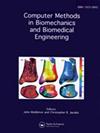基于排列重要性和集成学习的肌肉意图解码特征选择方法。
IF 1.6
4区 医学
Q3 COMPUTER SCIENCE, INTERDISCIPLINARY APPLICATIONS
Computer Methods in Biomechanics and Biomedical Engineering
Pub Date : 2025-07-14
DOI:10.1080/10255842.2025.2526017
引用次数: 0
摘要
肌肉信号是不确定的,包含巨大的主体间变化。该工作提出了一种基于排列重要性的权重计算的特定主题特征选择方法,以正确识别不同的手部运动。从精度、F1分数和计算时间三个方面对所提方法的性能进行了评价。研究发现,使用基于集成的分类器,只有25%的特征足以预测运动。准确率和F1分数增量约为3-5%,特征值仅为25%。与整个特征组所花费的时间相比,特征缩减显著地减少了近40%的训练和验证时间。本文章由计算机程序翻译,如有差异,请以英文原文为准。
A permutation importance and ensemble learning based feature selection approach for muscular intent decoding.
Muscle signals are indeterministic and contain huge inter-subject variations. The work proposes a subject-specific feature selection approach employing permutation importance-based weight calculation to identify different hand movements correctly. The performance of the proposed method is evaluated in terms of accuracy, F1 score, and computational time. The study finds that merely 25% of the features are enough to predict the movements using the ensemble-based classifier. The accuracy and F1 score increment are almost 3-5% with only 25% features. The feature reduction significantly reduces the training and validation time by almost 40% compared to the time taken for the whole feature group.
求助全文
通过发布文献求助,成功后即可免费获取论文全文。
去求助
来源期刊
CiteScore
4.10
自引率
6.20%
发文量
179
审稿时长
4-8 weeks
期刊介绍:
The primary aims of Computer Methods in Biomechanics and Biomedical Engineering are to provide a means of communicating the advances being made in the areas of biomechanics and biomedical engineering and to stimulate interest in the continually emerging computer based technologies which are being applied in these multidisciplinary subjects. Computer Methods in Biomechanics and Biomedical Engineering will also provide a focus for the importance of integrating the disciplines of engineering with medical technology and clinical expertise. Such integration will have a major impact on health care in the future.

 求助内容:
求助内容: 应助结果提醒方式:
应助结果提醒方式:


